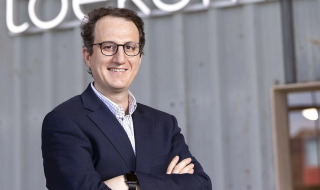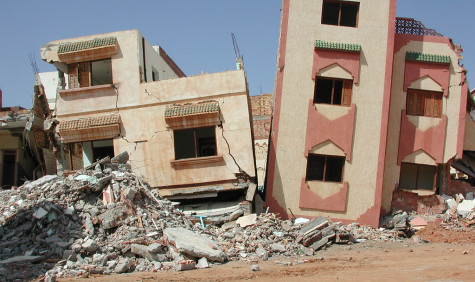Earthquakes in the cloud
What happens to a building in an earthquake? İhsan Bal, professor of earthquake resistance at Hanze University of Applied Sciences in Groningen, can map this out at lightning speed thanks to research with the SURF Research Cloud.
Key facts
Name: İhsan Bal
Position: professor and researcher
Organisation: Hanze University of Applied Sciences Groningen
Services: SURF Research Cloud and Research Drive
Challenge: processing and storing huge datasets for earthquake simulations
Solution: SURF Research Cloud provides easy access to a lot of computing power for large-scale simulations and for training AI models for prediction and analysis.
The year is 1999. İhsan Bal is studying engineering in Turkey’s Black Sea region when a major earthquake hits Istanbul. It’s the city where his parents live. On TV, he sees images of damaged and collapsed buildings, but it takes almost two days before he finally gets in touch with his parents. Fortunately, the house is still standing and they are unharmed. "At that moment, I found my calling as an engineer: earthquake engineering.”

Shake table experiment
Since 2017, İhsan has led his own research group in Groningen. It used to be the last place where you’d expect earthquakes but gas extraction in the area has changed that.. Fortunately, no buildings have collapsed so far, but damage is there. "A lot of cracks in a lot of houses," says İhsan.
Many Groningers are struggling with uncertainty about the near future: will there be new, stronger quakes? İhsan cannot answer that question. "You can never predict when an earthquake will happen somewhere. And besides, these artificially induced quakes are a unique phenomenon."
What he can do is provide insight into the vulnerability of buildings. If a quake then occurs, it's immediately clear where collapse is imminent and what exactly needs to be repaired.
Challenges for researcher and computer
However, this isn’t easy. For a start, earthquakes are high-frequency movements. İhsan: "To describe them, we work with 600 data points per second per sensor. So that really means a lot of data."
Second, all natural phenomena are inherently erratic. Two earthquakes of the same magnitude can have completely different consequences. The study of earthquake resilience is therefore all about statistics and probabilities.
"The SURF Research Cloud was much easier to use than I thought"
Third, it is not feasible to make buildings completely earthquake-proof. So you always have to accept some degree of damage. But this makes the consequences even more difficult to predict: when will the first crack appear and how long will it be?
All this poses considerable challenges to researchers as well as to their computer facilities, İhsan explains. "In the Netherlands, people are used to taking storms into account. So they simulate how a certain building reacts to wind loads. Such a simulation takes about 10 minutes."
"On the other hand, if you try to simulate what an earthquake would do to the same building, the computer is running for 24 or 48 hours."

"You can never predict when an earthquake will hit. What you can do is give insight into the vulnerability of buildings."
Full speed ahead with SURF Research Cloud
So İhsan and his staff need a lot of computing power. "When I just started here, I wanted a faster Linux computer. I did have the budget for that. But my colleagues here told me that wasn't a good idea. Because after a few years, that machine won't be fast at all. And meanwhile, you're stuck with maintenance. Not to mention data management and backups."
"Their alternative was the SURF Research Cloud: there all that is done for you. I followed their advice and it turned out to be a good choice. The Research Cloud was also much easier to use than I thought. I had to get used to only having a terminal window, but people both at SURF and here at Hanze were very helpful. And IT in itself is familiar territory for me. So within a few days, I was running full steam ahead."
Virtual shaking
What İhsan did with the computing and storage power was first to simulate how hundreds of virtual buildings reacted to 50 different earthquakes recorded ‘in real life’. "We did that on a SURF Linux machine with 22 CPU cores, each calculating one of those quakes. That went nice and fast. Each time, 22 instances of such a building were shaking simultaneously." This made it clear what kind of damage they suffered from different types of earthquakes.
"Machine learning is 'statistics on steroids'"
But the real gains came in the second phase of the study. There, İhsan used the same machine's graphics processors to train an AI model of each virtual building with just two earthquake recordings. "That is the ideal approach for such a statistical subject as mine. Machine learning is statistics on steroids."
It was a great success. "Training was very fast and the results were as reliable as the extensive simulations. With models like this, we can start creating ‘digital twins’ - virtual models - of real buildings. You then only need to install one sensor, in the basement of the real building. If an earthquake occurs, you can unleash the measurement data on the digital twin and see where the damage occurs there. In a few seconds, you have a picture of the condition on each floor."
Martini tower
So we can act much faster and more adequately in the unlucky event of severe earthquakes in Groningen. Could this also be a godsend for the Martinitoren? İhsan laughs: "That tower is lucky, because it is well outside the earthquake zone. But as an engineer, I do think it’s suspiciously leaning.”
Text: Aad van de Wijngaart
Header image: RNW.org
